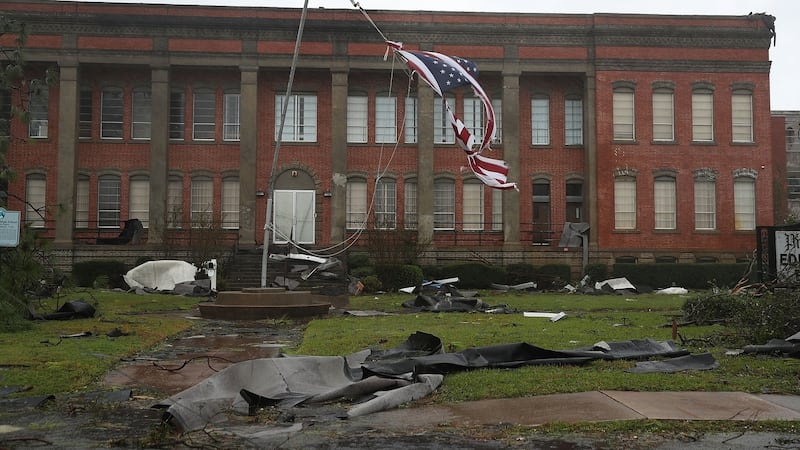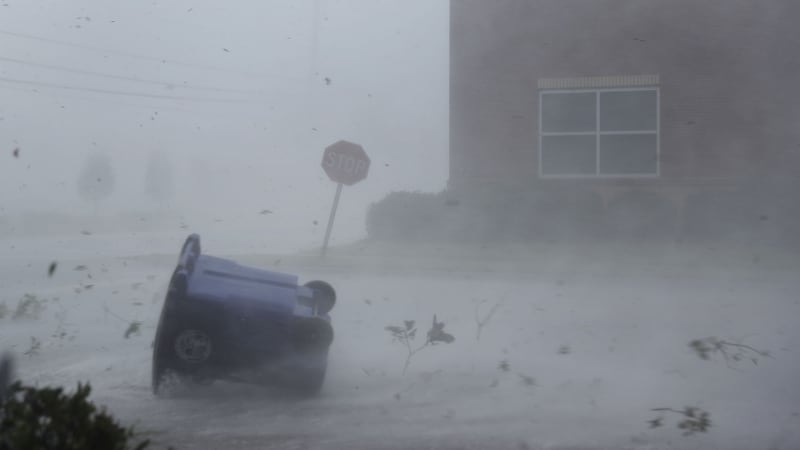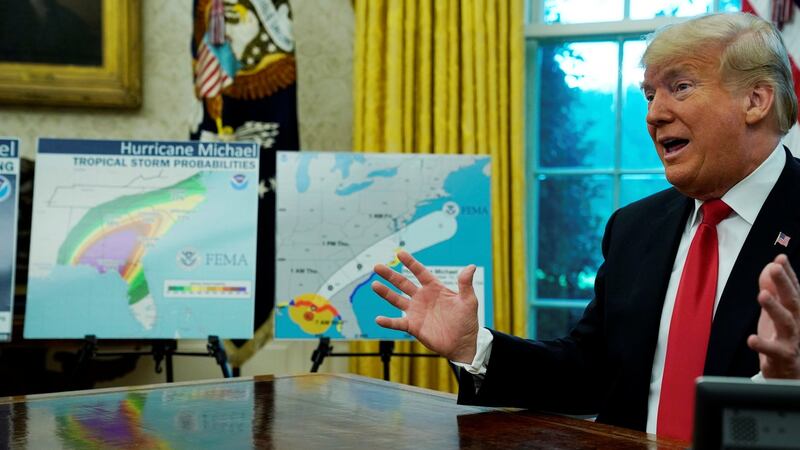Hurricane Michael crashed into the Florida Panhandle on Wednesday, flooding towns and ripping up trees with 249km/h winds and the potential for a devastating storm surge.
Michael is the most powerful storm to hit the Panhandle ever recorded, and the third most powerful to ever strike the US mainland.
The hurricane, which had caught many by surprise with its rapid intensification as it churned north over the Gulf of Mexico, made landfall northwest of the town of Mexico Beach at about 1.40pm local time as a Category 4 hurricane on the five-step Saffir-Simpson scale. Its sustained winds were just 3.2km/h shy of being an extremely rare Category 5.

Florida’s governor said it would be the worst hurricane to hit the region in a century.
Authorities told residents along the affected areas of Florida’s Gulf of Mexico coast that they had run out of time to evacuate and should hunker down.
The hurricane could drive sea water levels as high as 4.3m above normal in some areas, the National Hurricane Centre (NHC) said.

Only a couple of hours after Michael came ashore, floodwaters already were more than 2.3m deep near Apalachicola, said Ken Graham, director of the NHC.
About 162,000 homes and businesses were already without power in Florida, Georgia and Alabama, utility companies said.
In a Facebook Live post, Mr Graham said Michael would sustain hurricane-strength winds as it pushed inland to the Alabama-Georgia border
Michael’s menace was compounded by its relatively quick development, growing from a tropical storm to a Category 4 hurricane in about 40 hours.

“Satellite images of Michael’s evolution on Tuesday night were, in a word, jaw-dropping,” wrote Bob Henson, a meteorologist with weather site Weather Underground.
"This kind of sprung up for us quite quickly," said Andrew Gillum, mayor of Florida's state capital, Tallahassee, which lies about 40km from the coast and was preparing for a battering.
“We honestly felt we might have a tropical system and weren’t sure where it would go, and now we’re staring down the barrel of a Category 4 storm,” Mr Gillum told CNN.
Michael was forecast to move inland over the Panhandle on Wednesday afternoon local time, and across southeastern Alabama and southwestern Georgia on Wednesday night.
Evacuation
More than 2.1 million residents of at least 20 Florida counties were under mandatory or voluntary evacuation orders. Much of the area is rural and known for small tourist cities, beaches and wildlife reserves, as well as Tallahassee.
"Hurricane Michael is forecast to be the most destructive hurricane to hit the Florida Panhandle in a century," governor Rick Scott told reporters, speaking about seven hours before Michael was expected to make landfall.

Earlier, Mr Scott said on Twitter that it was too late to evacuate the target zone and that people who had stayed should immediately seek refuge.
Some of the storm’s most significant early impact was to offshore energy production. US producers in the Gulf cut oil production by about 40 per cent and natural gas output by 28 per cent on Tuesday, the Bureau of Safety and Environmental Enforcement said.

President Donald Trump declared a state of emergency for the entire state of Florida, freeing up federal assistance to supplement state and local disaster responses. Mr Trump will probably travel to the area hit by Hurricane Michael on Sunday or Monday, after the storm passes, he told reporters on Wednesday.
Apalachicola mayor Van Johnson had earlier told CNN: “My greatest concern is that some people are just now starting to take this storm seriously and are evacuating.
“And I just hope the others that have not made that decision get out while the roads are still passable and before the bridges close.”
‘Textbook case’
Mr Graham said Michael represented a “textbook case” of a hurricane system growing stronger as it drew near shore, in contrast to Hurricane Florence, which struck North Carolina last month after weakening in a slow, halting approach.
He said the storm would still have tropical storm-force winds when it reaches the Carolinas, which are still reeling from post-Florence flooding. Up to 30cm of rainfall was forecast for some areas.

The region should brace for “major infrastructure damage”, specifically to electricity distribution, wastewater treatment systems and transportation networks, Jeff Byard, associate administrator for Fema, told reporters on a conference call.
Many state offices, schools and universities in the area have been closed since Tuesday.
Among the people who had fled their homes was Betty Early (75), a retiree who joined about 300 fellow evacuees huddled on makeshift beds of blankets and collapsed cardboard boxes at an elementary school serving as an American Red Cross shelter in Panama City.
She was unsure how well her old, wood-framed apartment block would hold up. “I’m blessed to have a place to come,” she told Reuters. “My greatest concern is not having electricity, and living on a fixed income, losing my food.”
About 2,500 National Guard troops were deployed to assist with evacuations and storm preparations, and more than 4,000 others were on standby. Some 17,000 utility restoration workers were also on call.
Scott, a Republican running for the US Senate in November's congressional elections, declared a state of emergency in 35 Florida counties.
Georgia governor Nathan Deal declared a state of emergency on Tuesday for 92 counties in his state.
The last major hurricane to hit the Panhandle was Dennis in 2005, according to hurricane centre data. – Reuters









